
Emile Gallé: Lamp, c1898-1900. Collection Paul and Diana Tauchner. Photo: Sabine Schereck.
Bröhan-Museum, Berlin
7 December 2023 – 14 April 2024
by SABINE SCHERECK
In 1973, when West Berlin was still a rather grey place marked by the cold war, lovers of beautiful objects had a place to go: the villa of the entrepreneur Karl Bröhan, who had opened his private collection of art nouveau works to the public. At that time, art nouveau was not particularly fashionable. Later, his interest extended to art deco and functionalism. At the age of 60, he donated his collection to the city of Berlin and, in 1983, it moved to its new home, a classicist building opposite the Charlottenburg Palace, where an exhibition about art nouveau had first piqued Bröhan’s interest. Now a fixture within Berlin’s museums landscape, the museum is celebrating its 50th anniversary by going back to its roots with Belles Choses. Art Nouveau Around 1900, an exhibition dedicated to the origins of art nouveau in France and Belgium. The museum’s own collection is complemented by works of the private collectors Paul and Diana Tauchner in Munich and the Galerie Brockstedt.
With about 250 objects across several rooms on the ground floor of the museum, the exhibition provides an overview of the art movement, the environment in which it emerged, the key characters who promoted it, the role women played in it and the influence of Japanese art, which was a novelty in Europe at the time.
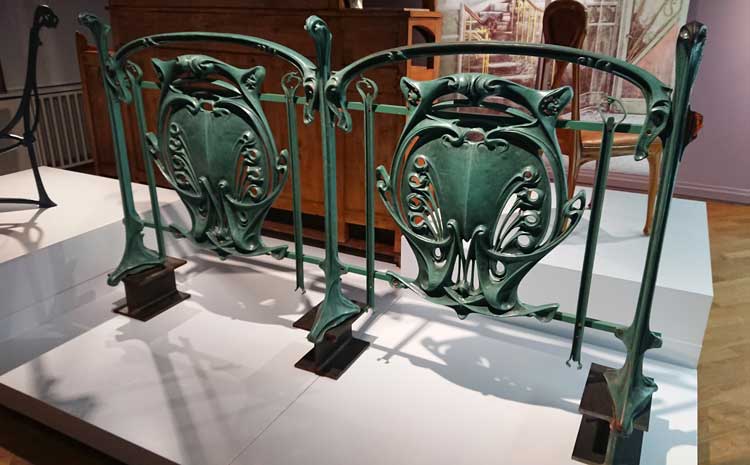
Hector Guimard, Railings for the Paris Métro, c1900. Permanent loan from the collection Brockstedt. Photo: Sabine Schereck.
The art nouveau that developed in France and Belgium is easily recognisable by its lush, sweeping and swirling lines that imitate nature, particularly plants. In a world that had increasingly become estranged from nature in the wake of industrialisation and urbanisation, the aim was to regain harmony and lift the spirits through nature’s beauty. In the 1830s, artists were already turning to nature when they took their easels to the woods, fields and beaches to paint nature as it presented itself to them. Then, in the 1890s, artists, predominantly designers, took the motifs they found in nature into the cities, to public buildings and private homes. It was the beginning of art nouveau, an all-encompassing movement that also sought to diminish the distinction between fine arts and applied arts.
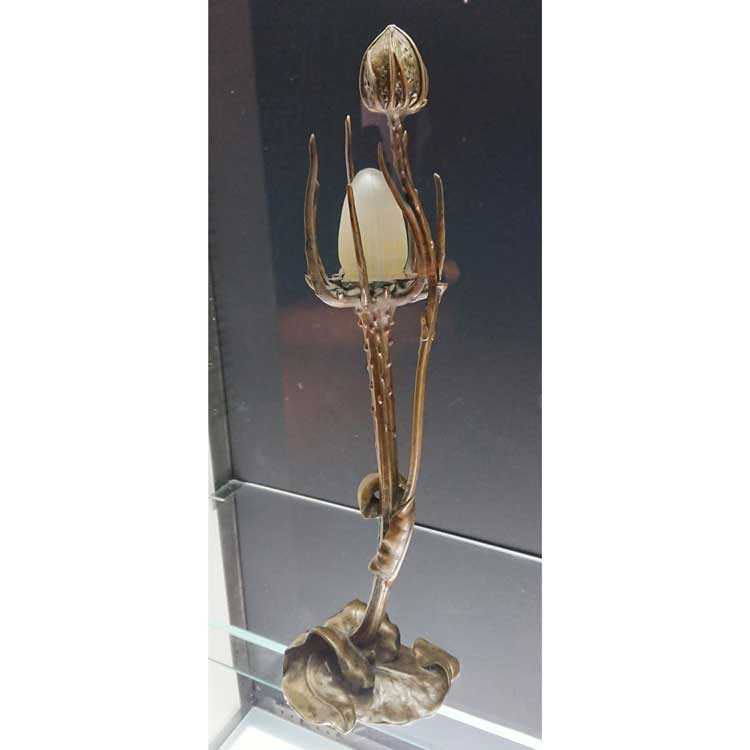
Maurice Bouval, lamp in shape of a thistle, c1903. Collection Paul and Diana Tauchner. Photo: Sabine Schereck.
It became visible in city streets, for example, with the floral-shaped ironwork of the entrances to the Paris Métro – an interesting counterpoint considering the Métro was a symbol of modern technology and a rapidly changing world. The architect Hector Guimard’s design for the Métro entrance (c1900) is displayed here and enables the visitor to travel, at least in spirit, to 19th century Paris. Floral ornaments on the facades of houses in the wealthier districts turned the streets in which the bourgeoisie lived into sights of beauty that could be enjoyed by those who could not afford to live in these buildings.
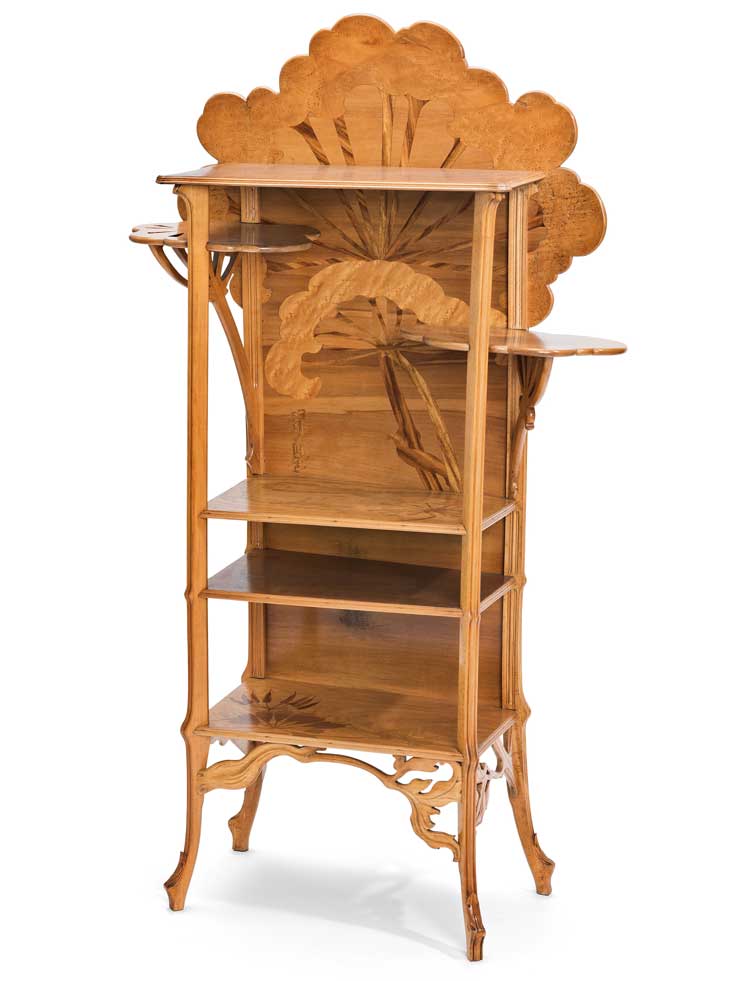
Émile Gallé, Shelf Ombelles, 1903. Realisation of the design: manufacture Émile Gallé, Nancy. Bröhan-Museum, Berlin. Photo: Martin Adam, Berlin.
The idea of all-encompassing art was related to Richard Wagner’s concept of Gesamtkunstwerk – the idea that all elements should come together to form a grand masterpiece – which determined the staging of his operas. When it came to interior design, it applied to tables, chairs, cupboards, wardrobes, beds, vases, lamps and so on. This is represented in this exhibition through a wooden furniture-set designed by Edward Colonna (c1899) and upholstered in a floral pattern. A wall-sized black-and-white photo of the designer Émile Gallé at his home in Nancy depicts the chair and shelf Ombelles (1902-04), which is on show here and illustrates the inspiration taken from nature. This use of nature as a model is further exemplified by various lamps on display, including one (c1903) by Maurice Bouval in the shape of a thistle.
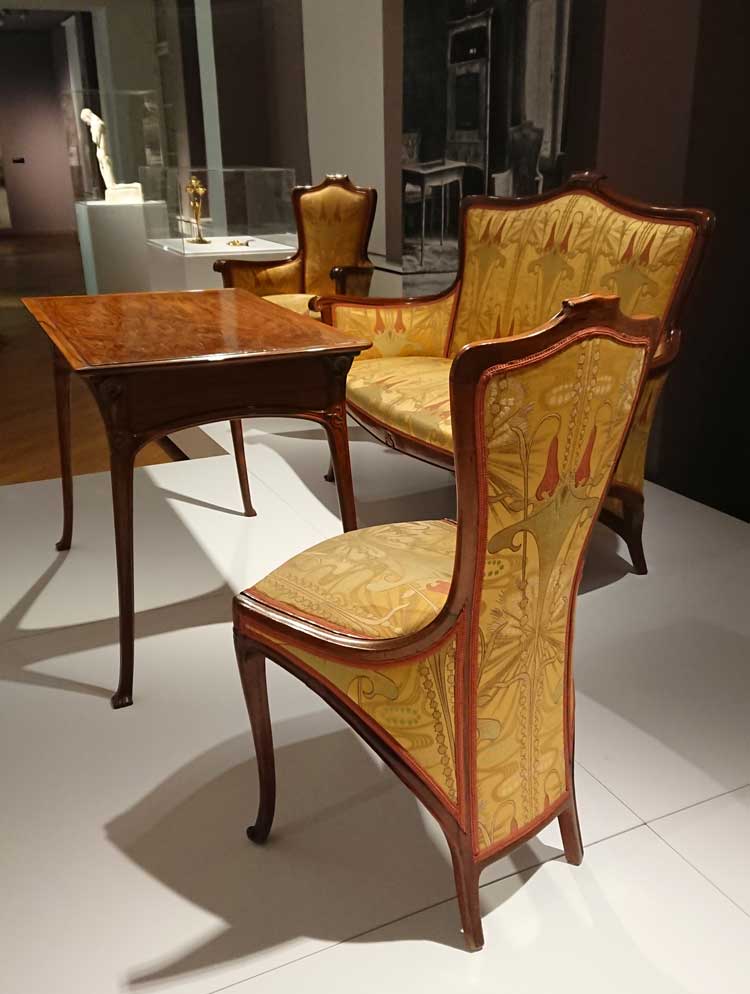
Edward Colonna, Furniture set consisting of table, sofa, armchair and chair, c1899. Collection Paul and Diana Tauchner. Photo: Sabine Schereck.
With regard to interior design, Gesamtkunstwerk and nature played a crucial role, but so, too, did the sense of light and space, something that this exhibition has left out. It was achieved through large windows and iron pillars, which enabled the construction of light airy spaces. This sense of space is one reason that art nouveau houses appeal still, such as the home of the art nouveau architect Victor Horta and the Solvay house in Brussels, which he also designed.
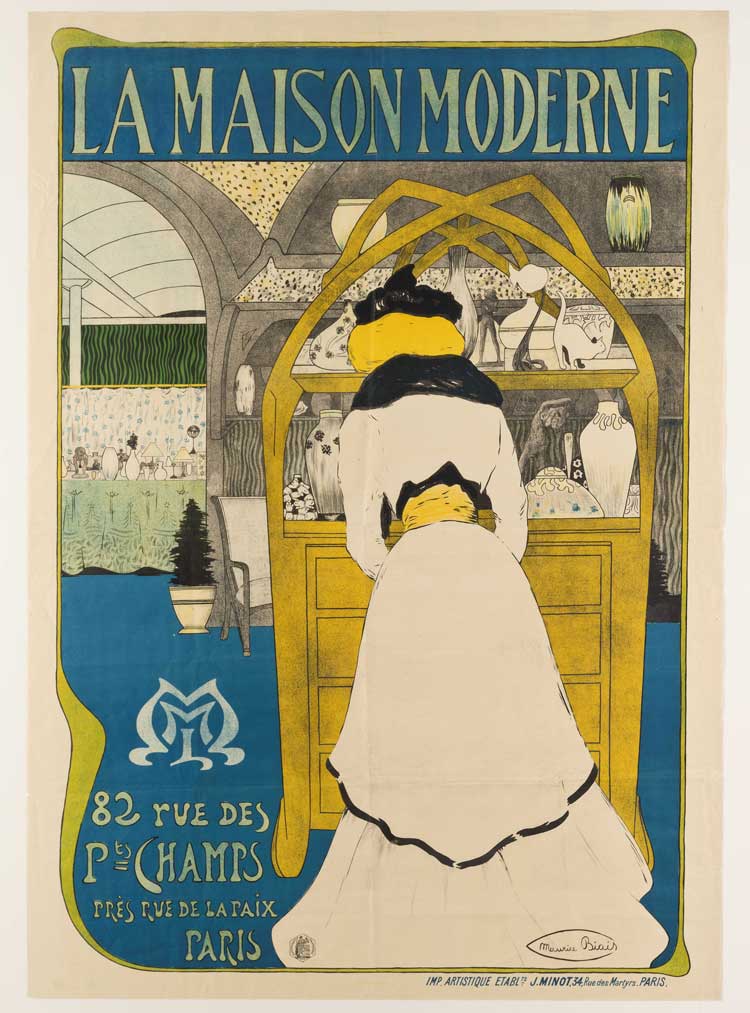
Maurice Biais, La Maison Moderne, c1900. Photo: Martin Adam © Archive Bröhan-Museum, Berlin.
The exhibition points to two art dealers who championed the new style: Siegfried Bing and Julius Meier-Graefe, both Germans. Bing had coined the term art nouveau when he opened a gallery in Paris in 1895 called Maison de l’Art Nouveau. There, he presented works in this new style ranging from tapestries, ceramics and stained glass to furniture, metalwork and prints. He collaborated internationally with the Belgian architect and designer Henry van de Velde, the French artist Henri de Toulouse-Lautrec, the leading figure of the arts and craft movement in Britain, William Morris, and the American glass artist and entrepreneur Louis Comfort Tiffany.
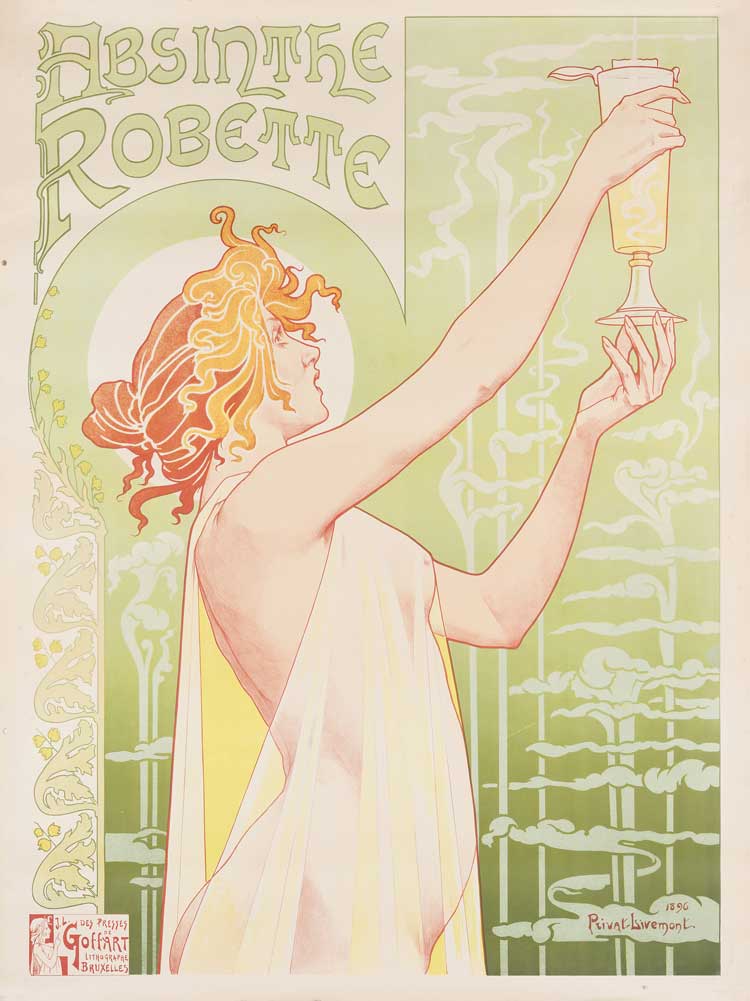
Henri Privat-Livemont, Absinthe Robette, 1896. Collection Paul and Diana Tauchner. Photo: ADER/E. Robin/E Brossette.
Meier-Graefe was mainly known as an art historian and writer, but in 1898 he, too, opened a gallery, La Maison Moderne, showcasing vases, lamps and furniture in the new style. Posters and photos of the gallery give a glimpse of what the place – with an interior design by Van de Velde – was like. The posters allude to the vital importance of printed material to spread the new style. First, there were numerous magazines, among them L’Art Décoratif edited by Meier-Graefe; second, graphic artists such as Henri de Toulouse-Lautrec, Alphonse Mucha and Henri Privat-Livemont created designs with lavish lines, often depicting young women with long flowing hair and dresses, to advertise whatever was requested: absinthe, the railway, cigarette papers, chocolate and – that was Mucha’s breakthrough in 1894 – theatre productions starring the actor Sarah Bernhardt.
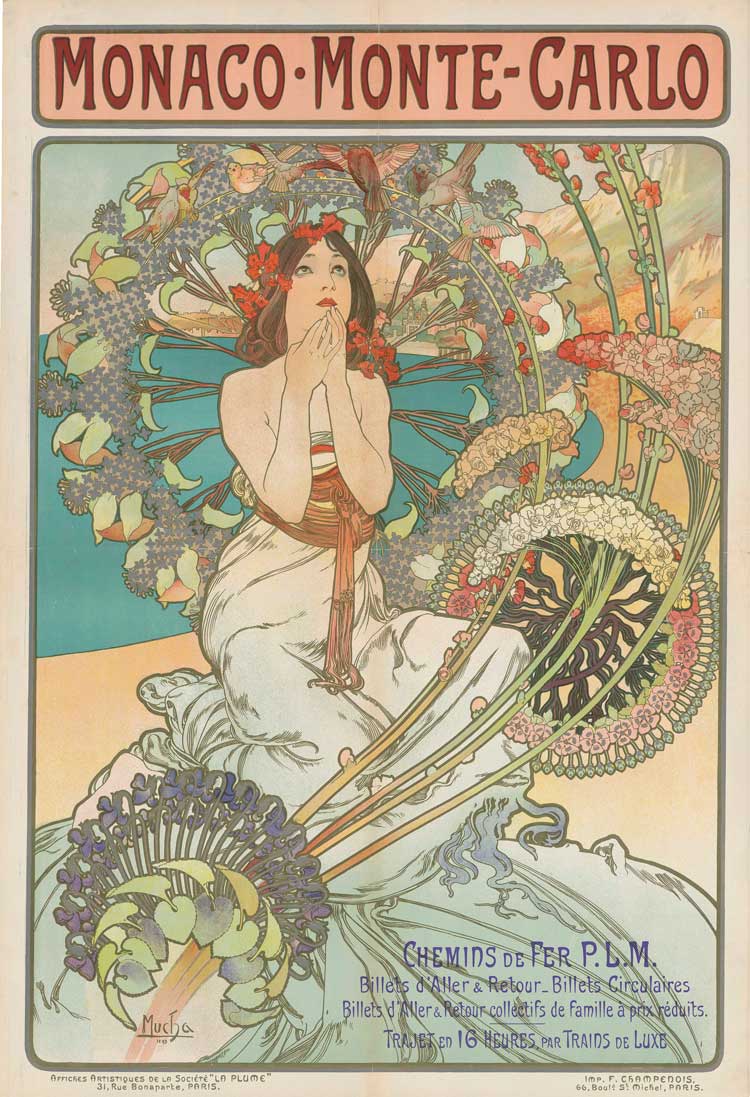
Alfons Mucha, Monaco Monte-Carlo, 1897. Print: Imprimerie F. Champenois, Paris, Bröhan-Museum, Berlin. Photo: Bassenge Auctions, Berlin.
In this context, the exhibition addresses two illuminating aspects that are linked: the cult of the star and commercial advertising. The vibrant entertainment scene of the period with its theatres, music and concert halls, particularly in Paris, produced celebrities such as Bernhardt and the dancer Loïe Fuller. Posters with images of these women not only advertised their stage shows but also a variety of products. In an idealised and stylised way, young women per se became the face of advertising. They appealed to men and women: to men, because of their often alluring and seductive poses, and to women, because of the goods promoted, such as chocolate or perfumes. The impact of women used in advertising can still be seen today.
Towards the end, the exhibition looks behind the world of pretty curls, waves and leaves to draw attention to lesser-known facets of art nouveau. One is the influence Japanese art had on it, the other, the political statement certain objects made. Art nouveau was generally an art movement that aimed to please and it was not used to express any political opinion.
After the American fleet broke Japan’s isolation and forced it to open up to the west in the 1850s, Japanese art was shown at London’s world fair in 1862. It created hype for Japanese design that was picked up by the arts and craft movement in Britain and was advanced in France by Bing. The Japanese woodcut, for example, had an impact on early art nouveau posters with its fine black lines. This is also masterfully reflected in Henri Rivière’s series of colour lithographs Les Trente-six Vues de la Tour Eiffel (1888-1902). The lithographs gathered here stand out as they touchingly capture the mood surrounding the Eiffel Tower, particularly in plates 1 and 3. The first shows the top of the Eiffel Tower appearing in the distance behind some autumnal chestnut leaves, the other depicts the bottom of the tower in a snowy landscape with small figures clutching theirs umbrellas and braving the weather. Rivière’s work is a clear reference to Katsushika Hokusai’s series Thirty-six Views of Mount Fuji (1830-32).
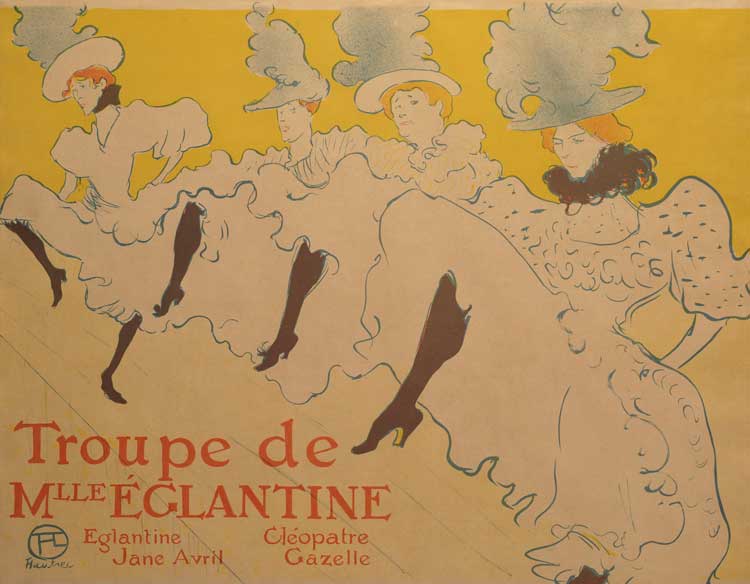
Henri de Toulouse-Lautrec, Troupe de Mlle. Ếglantine, 1896. Collection Paul and Diana Tauchner. Photo: Marianne Franke.
The beauty of plants mainly served decorative purposes, yet there were some that were used to carry a political message, as with Gallé’s so-called Dreyfus lamp (1898-1900). At the time, French society was deeply divided by the Dreyfus affair, in which the French army falsely accused the Jewish artillery officer Alfred Dreyfus of treason. By creating a lamp with a palm sapling (the palm tree symbolising the Jewish people), Gallé clearly sided with Dreyfus. The lamp additionally carries the line: “La vérité s’allumera comme une lampe.” (“The truth will enlighten itself/light up like a lamp.”)
This exhibition, curated by Anna Grosskopf, gives a general overview of the art movement but lacks inspiration and a wider perspective. With art nouveau now being anything but nouveau, the exhibition should have expanded its view. Instead, it leaves art nouveau in a remote aesthetic bubble of the past, where the contextual comments on themes such as colonialism seem like tokens for today.
There would have been many ways of taking the subject further and creating a connection for today’s audience. It could have taken on art nouveau’s early spirit of nurturing an international network and inspire visitors to explore more. Celebrating its art nouveau heritage last year, Brussels allowed the public to experience art nouveau homes from the inside. The exhibition also fails to illuminate the impact it had across Europe. Barcelona and Prague also became famous centres for art nouveau, and Glasgow, Darmstadt and Vienna developed their own versions of the style. Now, with the cold war long over and travelling being far easier than it was 50 years ago, there are more places to discover that feature lesser-known art nouveau architecture such as Helsinki, Riga, Budapest, Oradea in Romania, or even Turin.
The exhibition could at least have pointed to art nouveau buildings in Berlin, where the French-Belgian influence can be found in buildings such as the regional court in the district of Mitte or the numerous facades of houses in the districts of Charlottenburg and Schöneberg. This would have raised awareness that art nouveau is not a mere occurrence of the past but can still be admired in everyday life today.
The show also fails to note why the ideas of art nouveau may still be relevant. The endeavour to bring nature closer to city dwellers continues to be a current debate, particularly as research has shown how important nature is for our mental wellbeing. Nowadays, the walls of some houses don’t just bear artistic representations of leaves, but are “living walls” or vertical gardens growing real plants. The French artist and botanist Patrick Blanc, for example, covered the facade of the Musée du Quai Branly in Paris with plants. However, this “new art” is not one that can be marvelled at a century on. In this respect, the exhibition here, despites its shortcomings, is a testimony to enduring appeal of art nouveau.